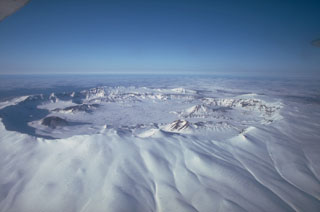Report on Okmok (United States) — December 1987
Scientific Event Alert Network Bulletin, vol. 12, no. 12 (December 1987)
Managing Editor: Lindsay McClelland.
Okmok (United States) Ash emission continues
Please cite this report as:
Global Volcanism Program, 1987. Report on Okmok (United States) (McClelland, L., ed.). Scientific Event Alert Network Bulletin, 12:12. Smithsonian Institution. https://doi.org/10.5479/si.GVP.SEAN198712-311290
Okmok
United States
53.43°N, 168.13°W; summit elev. 1073 m
All times are local (unless otherwise noted)
Minor eruptive activity continued . . . through December. Above-average, fairly continuous steaming was noted (by Milton Holmes and others) from 41 km E between 12 and 17 December. On 30 December at 1320 pilot T. Madsen observed constant brown-black ash emission drifting 80 km horizontally at 900 m altitude. Snow on the flanks was mostly covered with ash. He noted similar activity on 5 January, when an opaque plume was drifting NW at 1.2 km altitude for 30 km. A trapper, who has been on Umnak Island at the SE base of Okmok for the past several months, has reported several strong earthquakes followed by ash eruptions, but gave no dates.
Geological Summary. The basaltic Okmok shield volcano forms the NE end of Umnak Island in the Aleutian Islands. The summit of the low, 35-km-wide volcano is cut by two overlapping 10-km-wide calderas formed during eruptions about 12,000 and 2,050 years ago when dacitic pyroclastic flows reached the coast. More than 60 tephra layers from Okmok have been found overlying the 12,000-year-old caldera-forming tephra layer. Numerous cones and lava domes are present on the flanks down to the coast, including the SE-flank Mount Tulik, which is almost 200 m higher than the caldera rim. Some of the post-caldera cones show evidence of wave-cut lake terraces; more recent cones were formed after the caldera lake, once 150 m deep, disappeared. Eruptions have been reported since 1805 from cinder cones within the caldera, where there are also hot springs and fumaroles.
Information Contacts: J. Reeder, Alaska Division of Geological and Geophysical Surveys (ADGGS).

